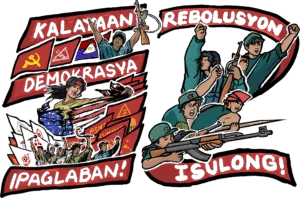Interview of LUIS G. JALANDONI
Chairperson, NDFP Negotiating Panel
By JM Ragaza, Philippine Collegian
Can you briefly narrate the history of the peace negotiations between the National Democratic Front of the Philippines (NDFP) and the Government of the Republic of the Philippines (GRP)? When was it started? Who initiated it?
Then President Corazon Aquino declared in March 1986, after the overthrow of the dictator Ferdinand Marcos, that she wanted to have peace talks with the revolutionary movement. The NDFP responded favorably. Peace talks started later in 1986 which resulted in the signing of a ceasefire agreement in November 1986.
Before the fall of Marcos, the legal democratic forces participated and supported Corazon Aquino's call for civil disobedience against Marcos.
The peace talks collapsed when a peasant march for genuine land reform was attacked by the military and police on 22 January 1987, causing the death of more than a dozen peasants and their supporters, and the wounding of over a hundred.
In December 1988, the NDFP announced its willingness to have peace talks. In 1989 an emissary of the Aquino government came to Utrecht, in the Netherlands. Then in September 1990 Congressman Jose Yap came for a one-week exploratory talk as an emissary of Pres. Aquino. On 31 August 1992 Rep. Yap, as emissary of Pres. Fidel Ramos, and his delegation met with Luis Jalandoni, NDFP representative and his delegation. They forged the landmark agreement, The Hague Joint Declaration of 1 September 1992.
For a brief history of the peace talks and the twelve agreements signed between 31 August 1992 until 31 March 2006, you can look up the NDFP website: http://www.ndfp.net for the Timeline Study of GRP-NDFP peace negotiations from 31 August 1992 to 31 March 2006 made by the Philippine Peace Center and the Chronology of the Peace Negotiations between the GRP and the NDFP: 1988-2006 – Exploratory and Preliminary Talks.
- What is the objective of peace negotiations between the government and the NDFP? Why do you think that the government is participating in such talks despite its obvious bias against the Left? On the other hand, why is the Left engaging in peace talks when its criticism of the current government is that it is there to perpetuate itself into power and uphold its economic and political interests? What are NDFP's gains in these peace negotiations?
The NDFP's objective in peace negotiations is to try to forge agreements that will address the roots of the armed conflict. That is, fundamental economic, social and political reforms for the benefit of the people. In addition, the NDFP worked for the Comprehensive Agreement on Respect for Human rights and International Humanitarian Law (CARHRIHL).
Through peace talks, the NDFP can widely disseminate and project its program for national and social liberation, which it considers the basis for a just and lasting peace. In the process, it has worked for the release of political prisoners.
It has also been able to get the support of various governments (the Norwegian Government, the current Third Party Facilitator in the GRP-NDFP peace negotiations; the Belgian government hosted the talks in 1995, and the Dutch government, the talks in 1996.) It has also secured several European Parliament Resolutions (1997, 1999, 2008) supporting the peace talks.
When the reactionary government refuses to address the roots of the armed conflict, and refuses to respect human rights and international humanitarian law (IHL), and refuses to negotiate social, economic and political reforms, it becomes all the more exposed as anti-people, anti-national, and against a just and lasting peace.
The reactionary government wants to create the false image that it is for peace, even as it wages a brutal war against the people and the revolutionary forces. At certain times, it needs to make propaganda. Then it wishes to make the revolutionary movement fall into the trap of capitulation.
The likes of Gloria Arroyo, Eduardo Ermita and Norberto Gonzales are out to destroy the revolutionary movement. But there are some elements in the Manila government that take the situation on the ground into account and are willing to negotiate agreements that are beneficial to the people.
Can you briefly describe to me how peace talks are conducted? What are the steps undertaken by both parties before entering into negotiations? Are there preconditions (both in principle and in process) on both parts before engaging in peace talks?
Usually both sides agree on the agenda. They exchange drafts of their positions before the meeting.
In The Hague Joint Declaration of 1 September 1992, both sides agreed not to have any preconditions that negate the inherent character and purpose of peace negotiations. This means the constitution of one may not be imposed on the other. It means no capitulation or surrender.
During the talks, in accordance with Ground Rules approved by both sides, the chairing of the meetings is shared alternatively by the chairperson of both panels. The Third Party Facilitator attends and assists, but does not chair the meetings. He is a facilitator, not a mediator or arbitrator who can present a solution binding on both parties.
When problems arise, both sides often agree to create “small committees” (3 persons on each side) to thresh out the problems and come up with proposed solutions to the negotiating panels.
But of course if agreements have been signed, like the Joint Agreement on Safety and Immunity Guarantees (JASIG), signed in 1995 and approved by the Principals of both sides, the NDFP demands compliance with the JASIG. Such compliance is an obligation arising from the agreement, not a precondition.
Both sides may make requests for goodwill and confidence building measures. The NDFP has carried out releases of prisoners of war as goodwill and confidence building measures. Examples are the releases of Army Brigadier General Victor Obillo and Army Captain Eduardo Montealto, Police Major Roberto Bernal, and Army Major Noel Buan.
In principle, why is it that the government should be the one to bring the rebel forces to the negotiating table?
There is no principle that requires that the reactionary government should be the one to bring the revolutionary forces to the negotiating table. It is actually both sides that agree to go to the negotiating table. The initiative or gesture can come from either side.
Sometimes this is helped by the Third Party Facilitator. Sometimes, peace advocates like the Philippine Ecumenical Peace Platform and Pilgrims for Peace help in urging both parties to come to the negotiating table.
By the way, in the JASIG, both sides agreed that peace talks are to be held in a neutral foreign venue.
What are the limitations of peace talks?
Peace negotiations are just one more form of legal struggle; another arena where both conflicting sides try to work out their big differences.
The other arenas of struggle are the revolutionary armed struggle against the reactionary armed forces in the countryside; the revolutionary and legal mass movements in the town and urban centers (mass actions, strikes, protest marches, and the like) against the anti-people and anti-national policies (for example, extrajudicial killings, torture, disappearances); there is also the struggle between the progressives and the reactionaries in the parliament.
In a speech, former Senator Tañada once said that the government seems to prefer resorting to endless dialogue because it is neither prepared nor ready to undertake concrete reforms that address substantive social issues. Does it still hold true today (Arroyo regime)? Why?
There is truth to what former Senator Tañada says. The Arroyo government now engages in psychological warfare and propaganda, trying to create the illusion that its counter-insurgency program Oplan Bantay Laya is succeeding, and that it can defeat the New People's Army militarily by 2010 or render it inconsequential.
It has not demonstrated the political will to negotiate and forge fundamental social, economic and political reforms.
Why is the NDFP still participating in peace talks after so many years? What are the prospects of peace talks given the current political and economic situation?
Through the 12 agreements signed, the NDFP demonstrates that it is a revolutionary force willing to negotiate for a just peace, and that it stands firmly for the fundamental interests of the people.
The CARHRIHL, if implemented, could improve the situation of human rights and compliance to international humanitarian laws. The Joint Secretariat holding office in Quezon City, supported by the Norwegian Government, offers a venue for complaints on human rights violations. It also publishes educational materials on HR and IHL in major Filipino languages, such as the Geneva Conventions and Protocols, besides carrying out training seminars in different parts of the country.
The current economic crisis, especially after the devastating typhoons, shows the urgent need for socio-economic reforms, even emergency measures, which could be taken up in peace talks.
But the Arroyo government appears to be more concerned with psywar and trying to cling to power than paying attention to the urgent needs of the people. So, prospects of peace talks are not bright at all.
But the NDFP remains open to resume formal talks on the basis of past agreements, compliance with the agreement on safety and immunity guarantees (JASIG) and the release of NDFP consultants and other political prisoners, and at least restart talks on the implementing CARHRIHL and socio-economic reforms, including urgent measures of rehabilitation and recovery after the devastating typhoons.
Finally, what do you think is the government's notion of peace? How about the NDFP's?
I think the Arroyo government's notion of peace is pacification of the revolutionary movement, trying to make it fall into the trap of capitulation through its DDR framework (Disarmament, Demobilization, Integration).
The NDFP's notion of peace is genuine land reform for the peasants, just wages and working conditions and respect for the rights of workers, peasants, women, youth, urban poor, indigenous people, professionals and other sectors. Education and health care for all, a country truly independent (free from US and other imperialist domination), a just and lasting peace, the fruits of the Filipino people's continuing struggle for national and social liberation.
Thank you very much.
Wishing you success in your research and writing your article.

